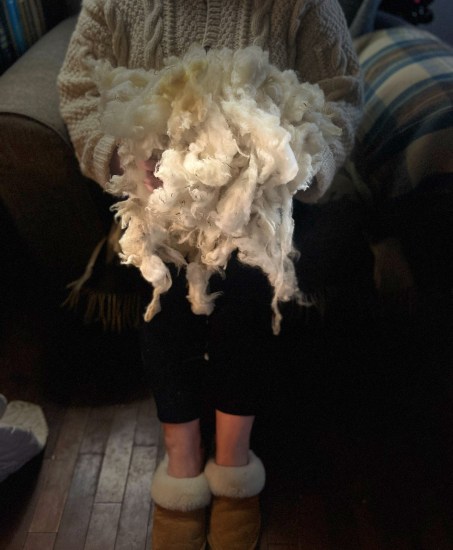
In the old days, we burnt the fields every year to add fertility back into the soil. It also helped with tick control. This was the old way before increasing housing density, and the lack of education demanding it was air pollution.
In the 80’s, my step-grandad once read the wind wrong, with the help of a bottle of Jack Daniels and burnt our century old sheep house to the ground. No sheep in it, thank goodness. It just wasn’t viable anymore to keep sheep, thanks to a decline in the demand for lamb meat/rise in convenience culture, and the popularity of fast fashion outshining wool and its benefits. Sheep weren’t profitable for many small farms to keep anymore.
I’m not sure they still are but I do it anyway. I try to help them earn their keep.
My most profitable way to do this is wool dryer balls (this isn’t an ad-I can barely keep up with the orders I have). Dryer balls replace the dryer sheet and their very, very harmful chemicals. It is ironic a fibre as old as time helps dry clothes naturally, and faster with a modern tool of time saving necessity, the clothes dryer. It is ironic that wool, when combined with the factory made clothes fibers of today, reduces static electricity.

Sheep are sheared for wool or if they are hair sheep like Icelandic or Kathadin, it is pulled and collected once a year. Cotswold breed sheep can get two shearings a year usually, and their fleeces are so valued for their long strand length. Sheep are single purpose (wool or meat), dual purpose (meat and wool) or tri purpose (manure for pasture regeneration, meat and wool) -regardless of why you are raising sheep, you will need a plan. A plan for breeding or raising bottle babies, shearing or pulling wool, grazing on pasture or dry lot feeding, keeping a ram or not, aging out or culling are all decisions we have had to make with our flock.
Some decisions have been made for us. Our oldest sheep, Willow is turning 13 this year. We bred her with a too large ram, Buddy from Ross Farm, and she had a much-too -large lamb and we lost the lamb through inexperience and almost lost Willow in the process. It was a heartbreaker. She is our single purpose ewe and barely that now, more of a family member. We had her mother till she was 14.
Buddy became quite a going concern of a ram, as rams should never be treated as pets but he was raised with all sorts of bad habits. Weighing a good 250 lbs, he became our meat sheep. I will not have an animal I am scared of on the farm and he nourished us for almost two years in good meat.
Dolly, a texel, bred to a North Country Cheviot came to us needing a bit of TLC. She is a bit of a hard keeper, as they say. She gave birth to Butter here on the farm, a lamb who became a wether, or casterated male as soon as possible. He would be for wool and meat. Allie, a North Country Cheviot came to us as a bottle baby. She had entropia in her eye, a condition in which the eyelid is turned inward and can lead to blindness, so she cannot be bred as it’s hereditary. She will be for wool only and companionship for the older ewes.

After Evan, my dear shearer, comes in June, I skirt the fleece, removing pieces that cannot be washed, and are matted and dirty, and I use those pieces in my garden along the swampy edge to deter slugs. They just hate it.
Shearing costs me $75 including gas and a jar of homemade pickles.
Then I tuck the fleeces away in burlap bags till winter. I wash the fleeces when the wood stove is keeping the house toasty warm, one fleece at a time, three times each finishing with a vinegar wash.

I spend nights by the fire, after the chores are done and the kitchen is put away, working with my wool. Sometimes I have some spun into yarn too. I dream of expanding the flock, reviving the humble lamb chop and having a wool blanket made for each child and grandchildren from our wool.
The old ways help keep us warm all winter.
Love Jenn xx

Our Australian Shepard, Willow loves working with her sheep.
